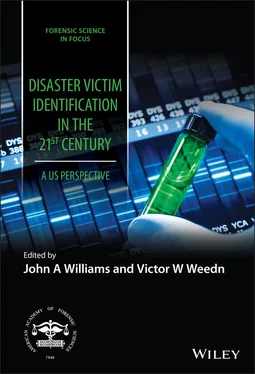During the early 1980s the National Funeral Directors Association recognized the need for a coordinated effort in responding to mass fatality events. This private response to a growing concern, in part due to several airline accidents with significant loss of life, led to the formation of DMORT. With DMORT came a team approach to DVI. Following a presidential disaster declaration, it is possible for an MEC to utilize DMORT, alleviating the problems that can arise when a jurisdiction is unprepared for or incapable of responding to the MFI. In addition to a fully operational disaster morgue team, a DMORT deployment comes with a fully outfitted disaster morgue. Since the mid-1990s when DMORT was first commissioned many states have developed their own mass fatality teams (i.e., FEMORS in Florida). Whether the mass fatality morgue is free-standing, as in DMORT, or incorporated into the MEC jurisdictional morgue, it is here that the work of DVI takes place. The mass fatality morgue is designed to be flexible, as are mass fatality teams. Together with logistical and support team members, the forensic science team members go about the process of identifying victims. Although all members of the DVI morgue contribute to victim identification, the majority of positive identification derives from odontology, fingerprints, and DNA. In the decades since the advent of DMORT, DVI has become increasingly technology driven. Where forensic odontologists once examined actual dental radiographs, the work is now accomplished digitally using software applications. Fingerprints can be scanned and uploaded to a regional or national database directly from the DVI morgue using technology no more complex than a personal cellphone. Advancements in rapid DNA processing may soon result in identifications made while the remains are still being processed through the DVI morgue stations. Together these advancements have increased the speed, efficiency, accuracy, and accountability in the identification process.
Prior to the mid-1990s the US approach to the DVI was a relatively uncentralized mix of federal and local deployed assets. On the heels of highly visible airline crashes and the terrorist attack of 2001 came DMORT, FEMA, and an ever-changing bureaucracy of the NRP and NRF (National Response Framework). The question to consider is whether our plan for the disasters of the late twentieth century is still valid for the first quarter of the twenty-first century. Currently, the MEC jurisdictions that must handle DVI vary from large urban ones with self-sufficient morgue capabilities for even the largest MFIs to small rural ones with few assets and little training to handle mass fatalities. Federal assets, like DMORT, were designed for the MFIs of the mid-1990s, i.e., transportation accidents. This model of morgue deployment has far less utility in handling other disasters, like that occurring on our southern border with the undocumented deaths of immigrants crossing illegally into the United States. Can the MEC system meet the challenges of a changing role for DVI? Add to this the contrast upgrading of technology, like rapid DNA testing, and the disparity between MEC jurisdictions becomes even more pronounced. DVI, whether we retain the DMORT model, or some form of it, or move to a novel approach, it must be adaptable for it be relevant to the needs of the twenty-first century and the ever-changing theater of mass fatality disasters.
Interlaced throughout the chapters of this book are references to law, domestic and occasionally international. The complexity of an MFI response would be far more difficult to approach if it were not for various legislative actions like the Stafford Act, FEMA, and the National Response Framework. These mandate and make possible our ability to respond to mass fatalities and carry out DVI. State responses are more varied but also contribute to the framework of DVI. In the end, though, it is the MEC jurisdiction and its legal requirement to establish cause of death, and, in so doing, identify the deceased, upon which DVI rests.
How the dead should be treated falls under the umbrella of ethical conduct. Every person should have the right to be identified and be treated with dignity after death. A statement attributed to William Gladstone makes this point: “Show me the manner in which a nation cares for its dead and I will measure with mathematical exactness, the tender mercy of its people, their respect for the law of the land and their loyalty to high ideals.” If the recent work treating the victims of COVID-19 in New York City by DMORT are an indication, despite our country’s differences, on this we as Americans still agree.
Конец ознакомительного фрагмента.
Текст предоставлен ООО «ЛитРес».
Прочитайте эту книгу целиком, купив полную легальную версию на ЛитРес.
Безопасно оплатить книгу можно банковской картой Visa, MasterCard, Maestro, со счета мобильного телефона, с платежного терминала, в салоне МТС или Связной, через PayPal, WebMoney, Яндекс.Деньги, QIWI Кошелек, бонусными картами или другим удобным Вам способом.












